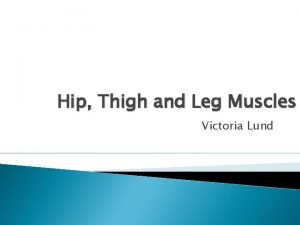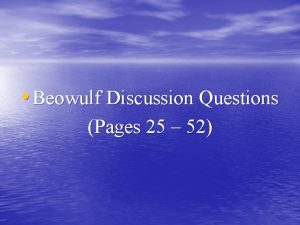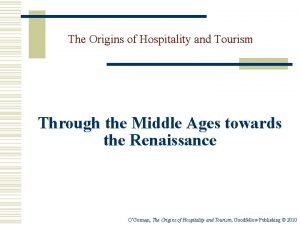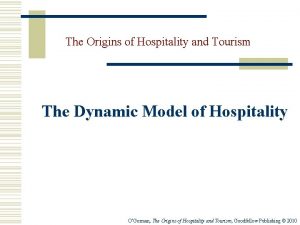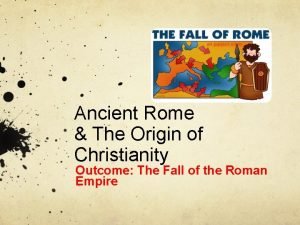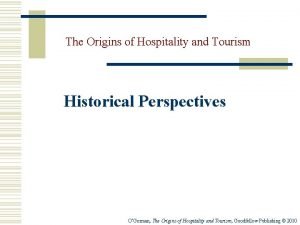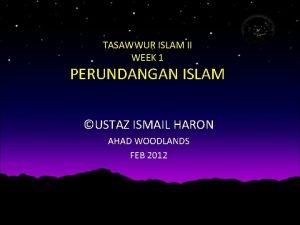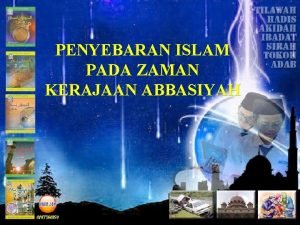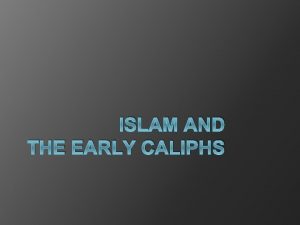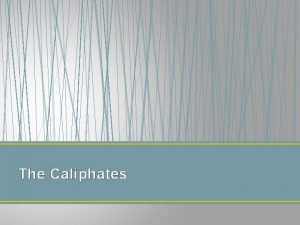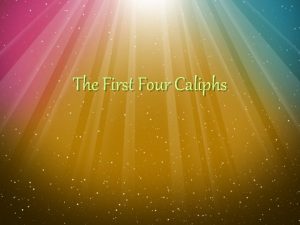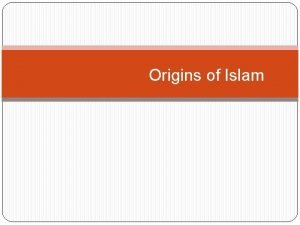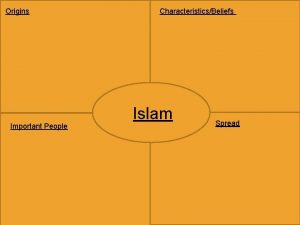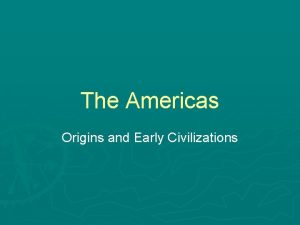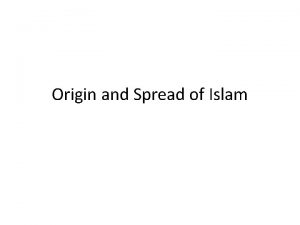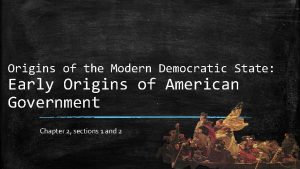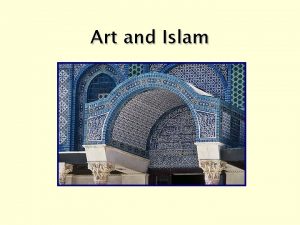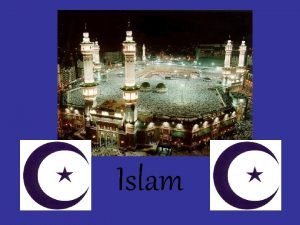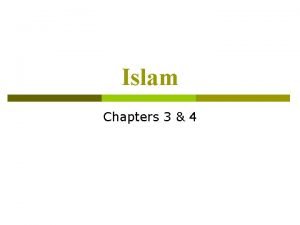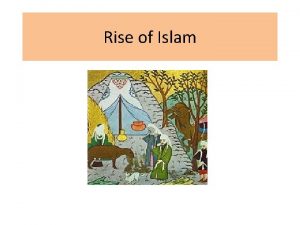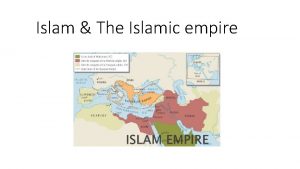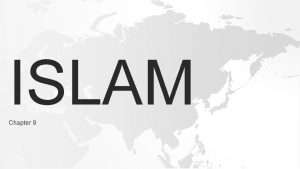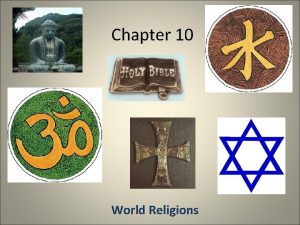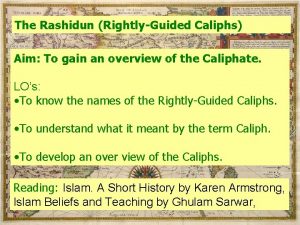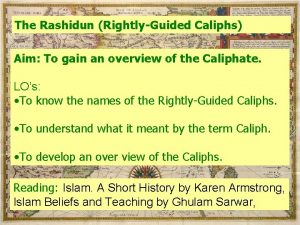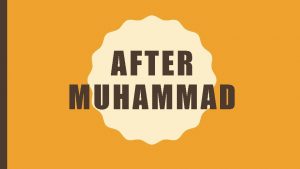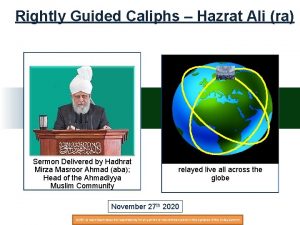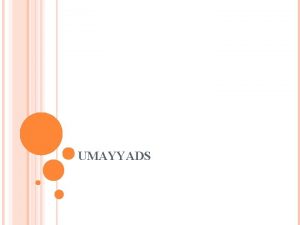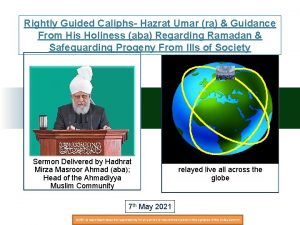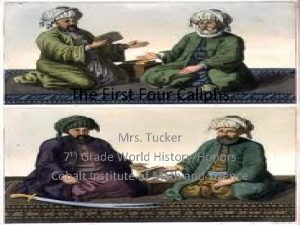ISLAM AND THE EARLY CALIPHS Origins of Islam

























































- Slides: 57

ISLAM AND THE EARLY CALIPHS


Origins of Islam

The Islamic World Originated on the Arabian Peninsula � Had long been inhabited by nomadic Arabs = the Bedouins � Located along important trade routes Indian Ocean, Mediterranean Sea, etc. � Gave rise to large commercial cities �

Bedouins � � � Herded sheep and camels Lived in fiercely independent clans and tribes Often engaged in violent wars with each other Variety of gods and ancestor/nature spirits Valued personal bravery and group loyalty

Arabia – Connections to the World Participation in long-distance trade � Location between the Byzantine Empire (to the northwest) and the Persian Empire (to the northeast) � �Result = many Jews, Christians, and Zoroastrians lived among the Arabs in Arabia �Many of their monotheistic ideas began to influence the Arabs

Mecca- founded by Umayyad Clan Established because of trade.

Ka’ba Houses the sacred black stone Pre-Islam: housed many deities within Islam: Used by Abraham and Ishmael to build the Ka’ba and become the cornerstone of the Kingdom of Heaven

Muhammad

The Messenger � � � Muhammad (570 – 632 CE) Born in Mecca A shepherd and a trader Troubled by the religious corruption and social inequalities of Mecca Often withdrew into the hills to meditate � 610 CE = he had an overwhelming religious experience – through Archangel Gabriel. � (Similar to the Buddha and Jesus) � Believed he was Allah’s messenger to the Arabs

Muhammad’s Spiritual Transformation � Visions c. 610 CE � Archangel Gabriel � Monotheism � Attracts followers to Mecca

The Messenger � Muhammad claimed to be the “seal of the prophets” �Meant he was the last in a long line of prophets, including Abraham, Moses, Jesus, and others Said he had God’s FINAL revelation to humankind � Wasn’t trying to start a new faith � More of an invitation to return to the old and pure religion of Abraham �


Islam An Abrahamic Religion Z Muslims are strict monotheists. They believe in the Judeo-Christian God, which they call Allah. Z Muslims believe that the Torah and the Bible, like the Qur’an, is the word of God. Z Peoples of the Book

Abraham’s Genealogy HAGAR ABRAHAM Ishmael 12 Arabian Tribes SARAH Isaac Jacob 12 Tribes of Israel Esau

The Prophetic Tradition Adam Noah Abraham Moses Jesus Muhammad


The Origins of the Qur’an Z Muhammad received his first revelation from the angel Gabriel in 610. 622 Hijrah Muhammad flees Mecca for Medina. * The beginning of the Muslim calendar (1 A. H. -in the year of Hijrah) Z Z 632 Muhammad’s revelations were compiled into the Qur’an after his death.

The Message � Rejected the other deities housed in the Kaaba � Rejected Christian idea of the Trinity � Salvation was determined by following the will of Allah � The Quran rejected: � Hoarding of wealth and materialism � Exploitation of the poor � Corrupt business practices � Neglecting widows and orphans � Abuse of women � The Quran demanded: � Social justice � Equality � Aid to the poor

Islamic Law No distinction between religious law and civil law � ONE LAW = the sharia law � �Found in the Quran � Regulated every aspect of life �Code of living: No pork, gambling, drinking, dishonesty, etc.

Hadith Serves to help in matters of jurisprudence. � Collections and sayings of Muhammad. �


1. The Shahada Z The testimony. Z The declaration of faith: There is no god worthy of worship except God, and Muhammad is His Messenger [or Prophet].

2. The Salat Z Prayers performed 5 times a day: * dawn * noon * late afternoon * sunset * before going to bed Z Wash before praying. Z Face Mecca and use a prayer rug.

2. The Salat Z The call to prayer by the muezzin in the minaret. Z Pray in the mosque on Friday.

3. The Zakat Z Almsgiving (charitable donations). Muslims believe that all things belong to God. Z

4. The Sawm Z Fasting during the holy month of Ramadan. Considered a method of selfpurification. Z No eating or drinking from sunrise to sunset during Ramadan. Z

5. The Hajj Z The pilgrimage to Mecca. Z At least once in a Muslim’s lifetime.

The Dar al-Islam The World of Islam 1 2 3 4 5

The Mosque Z The Muslim place of worship.

Dome of the Rock Built over a sacred rock in Jerusalem � According to Judaism � Site where Abraham was preparing to sacrifice Isaac � Site of Solomon’s Temple � According to Islam � Site of Muhammad’s ascension into heaven

After Muhammad’s Death � Umma organizes and chooses Abu Bakr as the first Caliph � Military expansion into Iraq, Syria, Egypt (weak Byzantine, Sassanid Empires) � Assassination of 4 th Caliph (Muhammad’s son in law) led to factional war � Shia vs. Sunni

Sunnis vs. Shi’ites Believe the caliph is the � Believe that the leader of rightful political and the Islamic community military leader of Islam should be a blood descendant/relative of � Believe the caliph should Muhammad be chosen by the Islamic community � Religious authority comes from prayer � Believe the caliph can be leaders called imams any devout Muslim � Imams = only ones that � Religious authority can correctly interpret comes from the larger divine revelations and Islamic community; Islamic law particularly ulama = religious scholars https: //www. youtube. com/watch? v= � p. QMpc. SQIv. Ok

Sunni vs. Shia

Why was Islam able to spread so quickly and convert so many to the new religion?

The Spread of Islam Z Easy to learn and practice. Z No priesthood. Z Teaches equality. Non-Muslims, who were “Peoples of the Book, ” were allowed religious freedom, but paid additional taxes. Z Z Easily “portable” nomads & trade routes. Jihad (“Holy War”) against pagans and other non-believers (“infidels”). Z

The Message: The th 6 Pillar Jihad = “struggle” in the way of god � “Greater jihad” = interior personal effort to avoid greed and selfishness, and to strive toward living a God-conscious life � “Lesser jihad” = “jihad of the sword” = belief that the Quran authorized armed struggle against the forces of unbelief and evil � versus � In order to: establish Muslim rule and defend the umma from the threats of infidel aggressors � Some interpret the Jihad to mean “Holy War”

Muslims in the World Today

Countries with the Largest Muslim Population 1. Indonesia 183, 000 6. Iran 62, 000 2. Pakistan 134, 000 7. Egypt 59, 000 3. India 121, 000 8. Nigeria 53, 000 4. Bangladesh 114, 000 9. Algeria 31, 000 66, 000 10. Morocco 29, 000 5. Turkey * Arabs make up only 20% of the total Muslim population of the world.

Umayyad Dynasty � Election of Muawiya led to split between Sunni and Shi’ite sects � Sunni � Capital at Damascus ◦ Caliph powerful and imperial � Continued expand under this dynasty; from Afghanistan to Spain ◦ Charles Martel; Battle of Tours ◦ Kept the Umayyad from expanding into modern day France.

Umayyad Dynasty (cont. ) ❖Government: �Bureaucracy �Muslims taxed for charity, non-Muslims paid taxes to support govt �Some intermarrying and conversion (few financial benefits at this time) �Converts not considered part of umma but mawali �People of the Book treated better than other beliefs but had to pay same taxes

Decline of the Umayyad Dynasty ❖Exclusion of non-Arabs in government led to problems and chaos as empire grew and demands grew for social and religious equality for Arab Muslims. ❖Mawali rebellion ❖Abbasid clan took control

Abbasid Dynasty � Claimed descent from Muhammad’s uncle; more acceptable to Shi’ites � Changed policies opening religion to all on equal basis ◦ Helped est. Islam as a universalizing religion � Cosmopolitan mix of cultures emerged � Golden Age of Islam � Problems with governing vast area

Abbasid Dynasty (cont. ) � Muslim shari’a (law) took shape � Ulama interpreted Qur’an and Hadith � Govt in Baghdad under a vizier – high official ◦ Provinces governed by emir (chieftain/prince) � Military commanders had power ◦ As army grew difficult for caliph to control commanders ◦ Ulama undermined caliphs powers due to control of shari’a.

Golden Age of Islam � Based on agriculture were also govt and religious centers � Dhows w/lateen sails traded across seas had lavish lifestyles � Professionals (teachers, doctors, merchants…) � The Malawi (Non-Arab Muslims) � The Dhimmis (Non-Muslims but protected) � Artisans – paid poorly but skills valued � Slaves – drudge laborers Economic Activities Social Distinctions ◦ Organized system of trade led to new crops and techniques ◦ Increase in food supply to support growth of cities � Caliphs

Dhows


Commerce and Slavery � Because Muhammad was a merchant, Islam respected merchants and allowed people to make money buying and selling provided they adhered to fair business practices � Islam allowed slavery, but could not enslave other Muslims, so most slaves converted to Islam � Most female slaves found themselves serving as concubines to Islamic men who already had 4 wives.

Free Women in Islam �Most women observe hijab, a term for modest dress in a general sense �Women could study and read, but could not do so in the company of men not related to them �Muhammad raised the status of women �Treated his wives with love and devotion �Insisted that dowries be paid to the future wife rather than her father �Forbade female infanticide �And his first wife was an educated woman with her own business, setting a pattern recognizing women’s abilities

Status of Women �Overall enjoyed higher status than Christian or Jewish women �Could retain ownership of property after marriage �Could remarry if widowed �Could practice birth control �The rise of towns and cities resulted in new limitations on women’s rights, symbolized by Harems: dwellings set aside for wives, concubines, and children of those women �Most history on how women were viewed before 1450 was written by men… so take it all with a grain of salt.

Golden Age of Islam (cont. ) � Arabic language was unifying force � Promoted partly due to Qur’an � Paper from China encouraged production of books � Poetry � Universities – madrasas (preserved writings of ancient Greeks and Indians)

The House of Wisdom � Founded by the caliph al -Mamun � Was a research center in Baghdad � Scholars translated texts from Greek, Persian & Indian into Arabic � Performed scientific experiments

https: //www. youtube. com/watch? v=4 Kl 4 v. X MWfq. M House of Wisdom

Golden Age of Islam (cont. ) � Muslim art; forbade lifelike representation of human figures, including Muhammad � *Persian art depicts Muhammad w/veil � Designs of garlands, plants, and geometric figures � Calligraphy � Mosques w/minarets

Golden Age of Islam (cont. ) � Arabic India) numerals (from ◦ Marker event – calculate large sums � Algebra � Optical Science � Pharmacology � Anatomy � Maps and geographical information

Medicine Physicians al-Razi and Ibn Sina = accurately diagnosed many diseases • Hay fever, measles, smallpox, diphtheria, rabies, diabetes � Arab doctors started: �Hernia operations �Cataract operations �Filling teeth with gold � Ibn Sina

Decline and Fall of the Abbasid Caliphate � Hostility increased between Sunni/Shi’ites � Difficult to hold diverse empire together from one central location � Slave revolts and peasant uprisings � Incompetent caliphs � Abbasids hired Seljuk Turks as soldiers; gained power � Seljuk leader Tughril took over Baghdad; caliph is figurehead � Mongols seized throne in 1258 ◦ The Mongol IL-Khan Empire Mongols seized throne
 Early cpr and early defibrillation can: *
Early cpr and early defibrillation can: * Hip thigh and leg muscles
Hip thigh and leg muscles Comparison of virtual circuit and datagram network
Comparison of virtual circuit and datagram network Where did christianity originate
Where did christianity originate Is beowulf italicized
Is beowulf italicized How do the origins of folk and popular culture differ
How do the origins of folk and popular culture differ Chapter 4 folk and popular culture
Chapter 4 folk and popular culture Foundations of government guided reading activity section 1
Foundations of government guided reading activity section 1 The origins of hospitality and tourism
The origins of hospitality and tourism The origins of hospitality and tourism
The origins of hospitality and tourism Ancient rome and the origins of christianity
Ancient rome and the origins of christianity The origins of hospitality and tourism
The origins of hospitality and tourism Hak asasi manusia tasawwur islam
Hak asasi manusia tasawwur islam Cara memelihara agama
Cara memelihara agama Penyebaran islam pada zaman kerajaan islam
Penyebaran islam pada zaman kerajaan islam Hình ảnh bộ gõ cơ thể búng tay
Hình ảnh bộ gõ cơ thể búng tay Frameset trong html5
Frameset trong html5 Bổ thể
Bổ thể Tỉ lệ cơ thể trẻ em
Tỉ lệ cơ thể trẻ em Voi kéo gỗ như thế nào
Voi kéo gỗ như thế nào Tư thế worm breton
Tư thế worm breton Alleluia hat len nguoi oi
Alleluia hat len nguoi oi Các môn thể thao bắt đầu bằng tiếng chạy
Các môn thể thao bắt đầu bằng tiếng chạy Thế nào là hệ số cao nhất
Thế nào là hệ số cao nhất Các châu lục và đại dương trên thế giới
Các châu lục và đại dương trên thế giới Cong thức tính động năng
Cong thức tính động năng Trời xanh đây là của chúng ta thể thơ
Trời xanh đây là của chúng ta thể thơ Mật thư anh em như thể tay chân
Mật thư anh em như thể tay chân Làm thế nào để 102-1=99
Làm thế nào để 102-1=99 độ dài liên kết
độ dài liên kết Các châu lục và đại dương trên thế giới
Các châu lục và đại dương trên thế giới Thơ thất ngôn tứ tuyệt đường luật
Thơ thất ngôn tứ tuyệt đường luật Quá trình desamine hóa có thể tạo ra
Quá trình desamine hóa có thể tạo ra Một số thể thơ truyền thống
Một số thể thơ truyền thống Cái miệng xinh xinh thế chỉ nói điều hay thôi
Cái miệng xinh xinh thế chỉ nói điều hay thôi Vẽ hình chiếu vuông góc của vật thể sau
Vẽ hình chiếu vuông góc của vật thể sau Thế nào là sự mỏi cơ
Thế nào là sự mỏi cơ đặc điểm cơ thể của người tối cổ
đặc điểm cơ thể của người tối cổ Thế nào là giọng cùng tên? *
Thế nào là giọng cùng tên? * Vẽ hình chiếu đứng bằng cạnh của vật thể
Vẽ hình chiếu đứng bằng cạnh của vật thể Phối cảnh
Phối cảnh Thẻ vin
Thẻ vin đại từ thay thế
đại từ thay thế điện thế nghỉ
điện thế nghỉ Tư thế ngồi viết
Tư thế ngồi viết Diễn thế sinh thái là
Diễn thế sinh thái là Dạng đột biến một nhiễm là
Dạng đột biến một nhiễm là Số nguyên tố là gì
Số nguyên tố là gì Tư thế ngồi viết
Tư thế ngồi viết Lời thề hippocrates
Lời thề hippocrates Thiếu nhi thế giới liên hoan
Thiếu nhi thế giới liên hoan ưu thế lai là gì
ưu thế lai là gì Hươu thường đẻ mỗi lứa mấy con
Hươu thường đẻ mỗi lứa mấy con Sự nuôi và dạy con của hươu
Sự nuôi và dạy con của hươu Sơ đồ cơ thể người
Sơ đồ cơ thể người Từ ngữ thể hiện lòng nhân hậu
Từ ngữ thể hiện lòng nhân hậu Thế nào là mạng điện lắp đặt kiểu nổi
Thế nào là mạng điện lắp đặt kiểu nổi Origins of sociology
Origins of sociology

